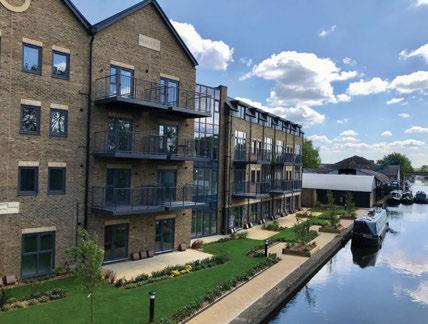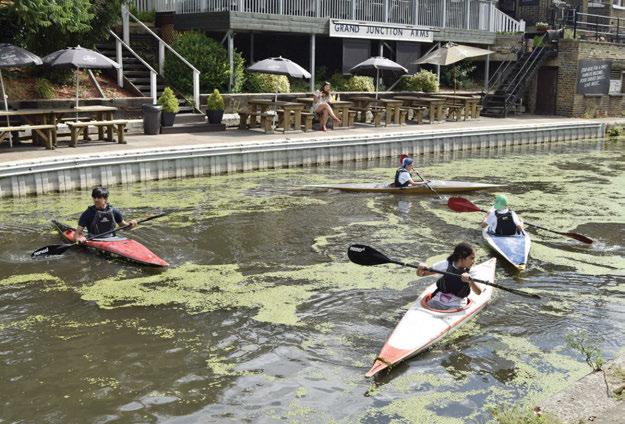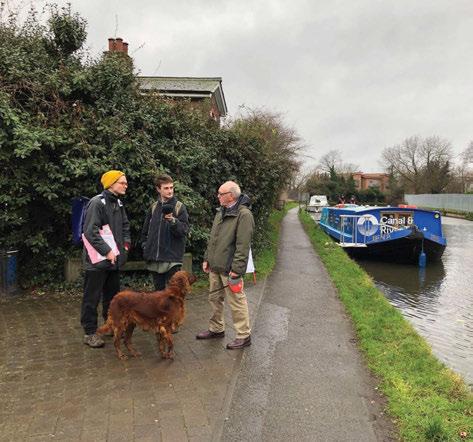
6 minute read
Regeneration
We explore the importance of planning with IWA West London Branch
Planning has been a key consideration for IWA from the beginning when mid-20th-century development threatened the very existence of our canals into the leisure age. Boating and the right to navigation were the levers to keep the canals open and the early campaigners saw the waterways as a national resource, a corridor open to all that connected rural areas with urban environments.
As a constantly evolving city, London is beset with planning applications for new and expanding developments every year, some of which have a direct or indirect impact on the waterways and the people who use them. For each application that has ramifications for the canals within a branch area, the documents – sometimes running to a hundred pages or more – are examined and a response provided on behalf of IWA where necessary. West London Branch covers the Grand Union Canal from Stockers Lock to Brentford, plus the Slough and Paddington arms, and while totalling just 36 miles, these waterways pass through nine different local authorities and 23 Conservation Areas, and 15 miles of canal are within Green Belt areas.
New pressures
Today new developments and expanding transport infrastructure in London, such as the impending HS2 rail network and the expansion of Heathrow Airport, threaten the aesthetics and heritage of our waterways landscape, while new pressures caused by increasing population density and the repurposing of towpaths as walking and cycling routes for commuters jeopardise the integrity of urban canals.
Along the 13-mile Paddington Arm, for example, there are targets for anywhere between 50,000 and 100,000 new homes over the next 20 years, and when looking at the impact on the waterway the influence from catchment areas beyond the line of the canal also has to be taken into account. Current towpath upgrades aim for a 2m-wide surfaced area with a 0.5m verge either side, but for how long will that be sufficient to accommodate the amount of traffic?
Environmental impacts are also on IWA’s list of priorities and the Association is looking at ways in which it can increase the biodiversity net gain of not only its own restoration works through the Waterway Recovery Group, but that of developers’ work along the canals too. We are always trying to go beyond mitigation and find ways to contribute towards reducing environmental degradation. New legislation will require mitigation but where IWA is involved in improvements along the waterways, we may be able to bank these and offer them to developers to offset losses elsewhere.
Sustainability
The majority of planning applications are not concerned with the waterspace but IWA is always looking at ways in which it can influence planning or the use of funding to support sustainable boating now and in the future while, at the same time continuing to preserve the heritage of our inland waterways. There has to be a balanced approached – IWA is not here to stop development, which is not only inevitable but, in some cases, required. Every major development needs looking at from the perspective of a boater and, perhaps more importantly, a towpath user or local person. In reality, the vast majority of applications are small-scale projects, and there are very few that are formally objected to by IWA.
Both Ray Gill and Roger Still have led the West London Branch on planning matters over the last few years, and IWA would like to thank them for their hard work. We’re looking to expand the number of planning officers across all of our branches, and if this is a role that appeals to you, please contact jenny.morris@waterways.org.uk. You do not need to have a background in planning, just an enthusiasm for the subject.
CASE STUDY ONE
Uxbridge Moor Conservation Area
In 2014 a planning application was submitted for new housing on the Grand Union Canal at Waterloo Wharf (close to Dolphin Bridge 186) and within the Uxbridge Moor Conservation Area. The apartment complex would replace a covered timber warehouse next to Uxbridge Dock – the historically significant Fellows, Morton & Clayton boatyard, which is still in use today. The initial proposals were objected to as noise from the boatyard could have affected the proposed residential development, leading to restrictions being imposed on the boatyard and thereby threatening its future viability. The planning officers also commented on the design of the apartments, which went through several iterations. The final design was accepted in 2017, featuring a small commercial area between the housing and the boatyard to act as a buffer, and the developer paid to have the roof of the dock re-covered and insulated to further mitigate any noise.

West London Branch had its say on the design of the new apartments at Uxbridge Moor, and highlighted the need to mitigate the impact of noise from the nearby boatyard.
CASE STUDY TWO
Old Oak and Park Royal Development Corporation

OPDC is aiming to encourage community leisure activity on the Grand Union Canal.
An ongoing project that West London Branch is involved with is the plan to regenerate a 650-hectare area through Old Oak, Park Royal and Kensal Green following the approval for a new HS2 and Crossrail interchange just to the north of Wormwood Scrubs.
The Old Oak and Park Royal Development Corporation first released its vision for what would essentially be a new town centre, complete with a commercial area supporting the creation of 65,000 new jobs and 24,000 new homes over the next 20 to 30 years, in 2015. The Branch’s interest is in how this will impact on the Grand Union Canal, which passes through the length of the site.
However, over the last five years there have been a number of problems affecting progress on the project, notably the building of the Elizabeth Line maintenance depot, a Crossrail site that occupies much of the area earmarked for commercial development in Old Oak South that lies directly next to the canal. Elsewhere, the company Car Giant, based in Old Oak North, made the case for remaining at its current location, which was accepted by the planning inspector, meaning the site can no longer be used for housing. Without these two key areas, the original OPDC vision has had to be scaled back, and some schemes that have already been approved could appear as strange, isolated developments along the canal, such as the proposed 24-storey block of flats at Scrubs Lane.
What was going to be a dramatic and sudden regeneration of the region is now a series of much smaller projects, although the longer-term housing and job creation targets remain in place. OPDC carried out research within the area and released its Canal Placemaking Study in 2018, which set out its new vision for the canal over the coming years. It focusses on encouraging leisure activity in safe, comfortable environments, facilitating movement both on and off the water, and nurturing the biodiversity of the canal as a green corridor.

OPDC OPDC’s vision for the canal corridor is multifaceted but ultimately intends to benefit all waterways users.

Research carried out by OPDC fed into its Canal Placemaking Study.
ODPC is currently developing a Lively Bridges scheme to signpost people to the canal from the surrounding areas, and encourage businesses and facilities to be based at these easily accessible sites. A new ramp from Old Oak Lane to the towpath is awaiting approval and work could start on this in spring 2021. Other schemes include working with local communities to fill gaps in planting, particularly on the off-side, establishing open-access workshops for use by boaters, installing more boater facilities, and encouraging waterside businesses to rethink their canal frontages for the benefit of people and wildlife.
The construction of the rail interchange is due to go ahead over the next ten years, so there is little doubt that regeneration will take place in the area; however, the effects of the Covid-19 pandemic on development, particularly in relation to office-based working, could have an impact both in the long and short term. West London Branch will continue to monitor the planning applications and work with OPDC to ensure any changes to the line of the canal are beneficial to all waterways users.









